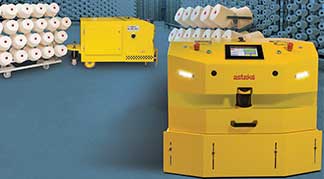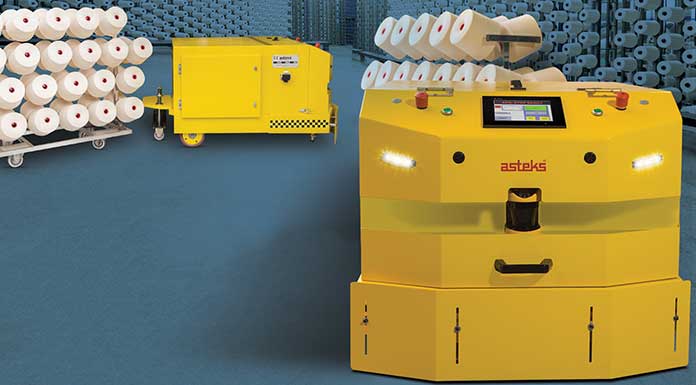
With a history of 50 years in apron, cots and production technologies, Asteks does not only add strength to the textile industry with their innovative solutions. The 101- AGV Automatic Guided Vehicle, on what the company has a long-standing R&D period, has achieved successful results both in-house and in the mills of major textile manufacturers. Commercially available for sale to the market, AGV provides automation that minimizes the need in man power on transporting the goods in the mill. This contributes to lower labour costs and to increase working efficiency. In addition, staff-related accidents are brought to minimum levels by the use of AGV. The quality of the work done is also standardized by AGV and the work schedule is maintained.
The AGV operates automatically without man attendance, and carries or pulls loads weighing between 2 and 4 tons. AGV, which is appealing to many industries with this carrying capacity, can be programmed with its advanced software and can perform stop and continue operations at the designated stations. Being already in use in Turkey’s leading textile companies, AGV proved to meet the required qualifications in transporting yarn and fabric along the designated line. AGV, that acts as a smart load carrier in the mill, can turn around 360 degrees and in a narrow space. For the operation of AGV, it is sufficient to have a line as good space as to the width of the load and the trolley. The AGV follows the magnetic line, and stops automatically with audible and light warning systems when it encounters an obstacle, thus preventing accidents.
It draws attention with its carrying power and safety
The AGV Automatic Guided Vehicle is one of the best optimum solution for on-site goods transportation in all sites having not bad floor conditions. It has a height of 610 mm, a width of 760 mm and a depth of 1,210 mm, can draw load weighing up to 4 tons with its minimalist design. The secret of AGV’s power is based on its AC motor and inverter technology. AGV vehicles, that guarantee long lasting performance despite the short charging time, have the compatibility of working individually or as a group.
Asteks Marketing and Sales Manager Sabri İlknur reminded that they have launched the AGV at ITM 2018, and said they give importance to automatic guided vehicles. Explaining that the vehicle has been used for 5-6 years in ASTEKS’ own production facility, İlknur stated that they received positive feedback with successful results in the factories in where they have installed it. “A very important solution to discipline the production process,” said İlknur, and continued as follows; “Having the increase in labour costs year by year in all production environment, AGV provides a great advantage to business owners. As you know, current Industry 4.0 solutions include automatic guided vehicles. These advanced vehicles fulfil the functions of programming, planning and schedule in-house logistics needs.”
AGV is successfully used in Küçükçalık Tekstil
Hakan Mercan ,who is the Technical Director of Turkey’s one of the best established textile enterprises, Küçükçalık Tekstil; said that the AGV vehicle is installed on their dyeing and finishing house in July 2018. Mercan; “Installation was completed in a very short time. As the vehicle’s travel path was determined and a sheet metal was set up along this path. AGV follows these metal paths with the help of sensors. Establishment of the line and training for the use of the vehicle was completed within 2-3 days; and we started to use it.” Mercan said the path is about 400 meters in length; “With the AGV vehicle, fabrics that are opened on top fabric opening machines are transported from here to washing machines. After washing, we use AGV to transport the fabrics to the stenter and printing sections.”
According to Mercan, the biggest advantage of the AGV vehicle is its long battery life; he said even at very busy working conditions, they can easily use it 3 days without recharging. Mercan gave the following information; “The AGV is re-charged rapidly in a very short time. This again creates a very advantageous situation in terms of productivity and efficiency in transportation. Even though the vehicle is receiving its energy from the batteries; it can convert the direct current (DC) to alternating current (AC) and work with 220V AC. Inverter motors have significantly longer charge usage time. With AGV we save time and reduce labour. Using it without the operator reduces both time and labour costs.”
Hakan Mercan stated that Automatic Guided Vehicle has many potentials to be developed and shared their opinions about use with ASTEKS and in return they received a positive response about R&D activities. Mercan finished his words as follows: “Starting from the installation of the device, Asteks has provided continuous support. They have worked to eliminate the disruptions rapidly, and have provided spare parts support. We were very pleased with the support given both the remote and the on-site.”
There is an encouraging market potential for AGV
Sabri İlknur explained that Automatic Guided Vehicle have been first introduced to ASTEKS’ existing ordinary business field; textile companies, and expressed that the successful results here constitute a strong reference for other industries. İlknur said; “We are in talks with domestic and foreign companies for sales. It was developed not only for a single industry; but also for the logistics needs of all different types of industries. We see a good potential for Automatic Guided Vehicle particularly in Turkey”.
Stating that semi or end products transportation within the factory is an important point for the production lines; İlknur repeated that the realization of this process with Automatic Guided Vehicle contributed positively; to both the costs and the quality of work. İlknur underlines that the Automatic Guided Vehicle pulls the load on its back, unlike the forklift; “Because the load is behind, unwanted accidents are prevented. With its superior radar system, Automatic Guided Vehicle can detect obstacles and stop. An audible warning system also supports this safety. Thus, the security of both the load and the employees in the mill is increased.”


